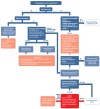Accidental Hypothermia: 2021 Update
- PMID: 35010760
- PMCID: PMC8744717
- DOI: 10.3390/ijerph19010501
Accidental Hypothermia: 2021 Update
Abstract
Accidental hypothermia is an unintentional drop of core temperature below 35 °C. Annually, thousands die of primary hypothermia and an unknown number die of secondary hypothermia worldwide. Hypothermia can be expected in emergency patients in the prehospital phase. Injured and intoxicated patients cool quickly even in subtropical regions. Preventive measures are important to avoid hypothermia or cooling in ill or injured patients. Diagnosis and assessment of the risk of cardiac arrest are based on clinical signs and core temperature measurement when available. Hypothermic patients with risk factors for imminent cardiac arrest (temperature < 30 °C in young and healthy patients and <32 °C in elderly persons, or patients with multiple comorbidities), ventricular dysrhythmias, or systolic blood pressure < 90 mmHg) and hypothermic patients who are already in cardiac arrest, should be transferred directly to an extracorporeal life support (ECLS) centre. If a hypothermic patient arrests, continuous cardiopulmonary resuscitation (CPR) should be performed. In hypothermic patients, the chances of survival and good neurological outcome are higher than for normothermic patients for witnessed, unwitnessed and asystolic cardiac arrest. Mechanical CPR devices should be used for prolonged rescue, if available. In severely hypothermic patients in cardiac arrest, if continuous or mechanical CPR is not possible, intermittent CPR should be used. Rewarming can be accomplished by passive and active techniques. Most often, passive and active external techniques are used. Only in patients with refractory hypothermia or cardiac arrest are internal rewarming techniques required. ECLS rewarming should be performed with extracorporeal membrane oxygenation (ECMO). A post-resuscitation care bundle should complement treatment.
Keywords: accidental hypothermia; cardiac arrest; cardiopulmonary resuscitation; emergency medicine; extracorporeal life support; rewarming.
Conflict of interest statement
The authors declare no conflict of interest.
Figures




References
-
- Paal P., Brugger H., Strapazzon G. Accidental hypothermia. Handb. Clin. Neurol. 2018;157:547–563. - PubMed
-
- Paal P., Gordon L., Strapazzon G., Brodmann Maeder M., Putzer G., Walpoth B., Wanscher M., Brown D., Holzer M., Broessner G., et al. Accidental hypothermia-an update: The content of this review is endorsed by the International Commission for Mountain Emergency Medicine (ICAR MEDCOM) Scand. J. Trauma Resusc. Emerg. Med. 2016;24:111. doi: 10.1186/s13049-016-0303-7. - DOI - PMC - PubMed
Publication types
MeSH terms
LinkOut - more resources
Full Text Sources
Medical

